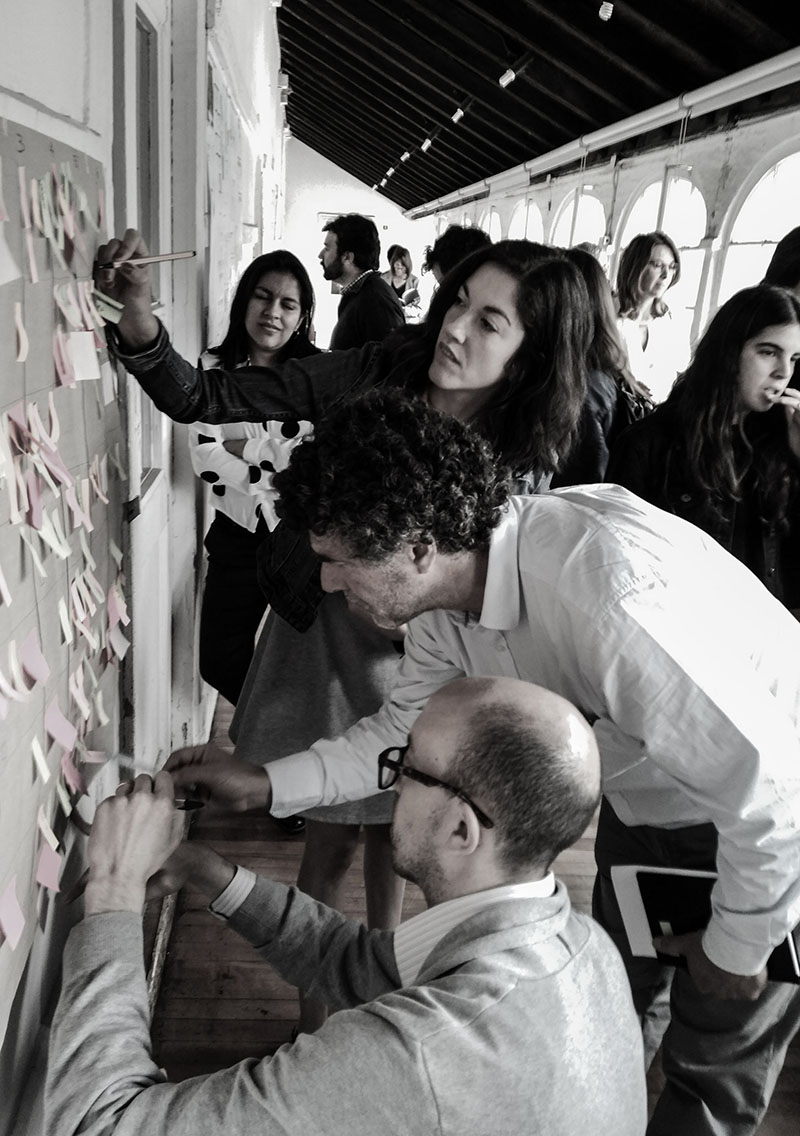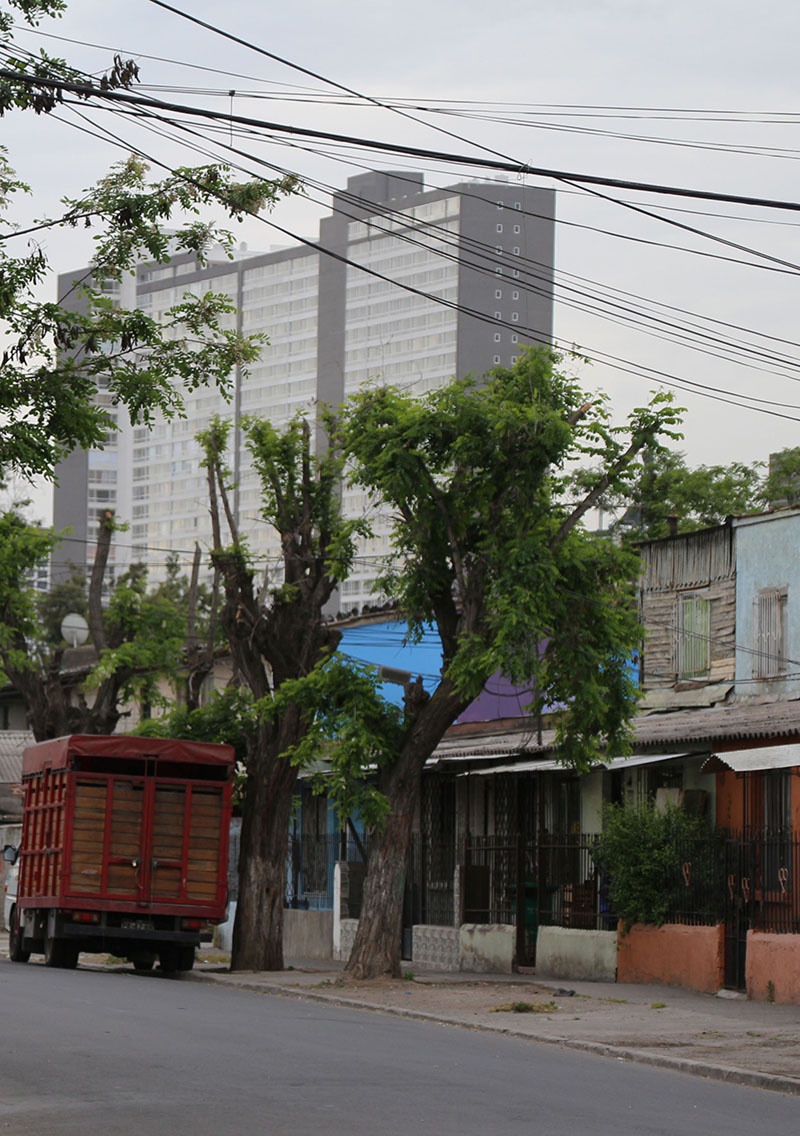
This publication is a joint project between the Department of Management in the Built Environment at Delft University of Technology, and the School of Architecture at Pontificia Universidad Católica de Chile, which seeks to reflect on alternative housing production models that have arisen in response to social, economic and political changes in both contexts. Although the experiences have followed different paths and therefore, have had different results, they share a common goal: the search for alternative housing models that are collaborative, affordable and have the potential for regenerating urban neighborhoods. The first milestone of the cooperation between both institutions was an academic experience in a workshop format carried out at Santiago in November 2017. The workshop titled: “Imagining housing renewal in deprived areas” became an opportunity to discuss among scholars, students, civil society organizations, and the community. As a result of this debate, a number of topics and questions were identified, which form the basis of the conceptual framework of this publication. Through a compendium of short articles, this book presents an academic debate regarding collaborative housing processes in urban regeneration, stemming both from local experiences and from the identification of north-south and south-north perspectives.
BOOK DATA
Publisher TU Delft Open // Book Editors Luz María Vergara, Cristián Robertson, Darinka Czischke, Elke Schlack, Rodrigo Tapia // Publication date November 2019 // Pages 176 // Full color// ISBN 978-94-6366-222-2
Editorial
-
This publication is part of an academic collaboration initiative between the Pontificia Universidad Católica de Chile and Delft University of Technology. It seeks to reflect on the development of alternative housing production models that have arisen in response to social, economic and political changes in both contexts. Although these experiences have followed different paths and have had different results, they share a common denominator: the search for alternative housing models that are collaborative, affordable and have the potential for regenerating urban neighbourhoods. We argue...
Articles
-
As an introduction, this chapter explains the main differences and convergences in the context of housing provision between Chilean and European cities. The chapter describes moments of housing provided by the Welfare States and moments in which housing rights are subject of major financialization. Here, the text describes what this publication wants to highlight: ‘the culture’ of the collective in housing provision. Despite the different traditions and cultural contexts in cities in the north and in the south, the core question remains the same: how do the inhabitants in the city agree...
-
This chapter briefly reflects on European social housing models and mainly discusses opportunities for housing cooperatives in the Dutch housing system. Since the introduction of the new Housing Act in 2015 in the Netherlands, there are legal opportunities for social housing tenants to form cooperatives. However, in practice, this does not happen a lot yet. From our analysis of the Dutch housing systems it is concluded that it is unlikely that it will take place on a larger scale, among others due to a lack of tradition (path dependency) and support from housing corporations – the main...
-
Against the backdrop of the current housing crisis, Europe has seen the (re)emergence of collectively self-organised housing projects. Collaborative housing stands as an umbrella term for the wide range of these housing forms, where groups of residents collectively design, develop and inhabit housing. This chapter provides a brief characterization of the motives underlying these new types of housing forms, and lays out challenges and opportunities that these projects entail. In doing so, it applies the concept of co-production, which signals a new paradigm in the way of conceiving the...
-
Collective habitat has been part of the housing history in Chile through the poor inhabitant's incursion in the city since more than one century. First, as round rooms, ‘cites’ and ‘conventillos’, and afterwards as ‘colectivos’. Later in informal settlements that evolved into self-organised and self-built neighbourhoods. During the last decades, in social condominiums. This form of co-habitation has adopted different shapes according to their historical moment, the spatial configuration of the places that inhabitants stayed or co-produced, the social and/or political organisation, the...
-
The neighbourhoods 9X18 emerged from a housing policy promoted in the 60s in Chile. They represent today a particular way of collective habitat in relation to their neighbourhood scale and to the interior of each plot. They are territories constituted and built by familiar and community networks. In Santiago, they are 466 neighbourhoods, and 216.000 lots between 160 and 250 m2, with a 38% of public space surface and an excellent pericentral location. Here, there is a lot to observe, learn and protect; and a tremendous potential that needs to be explored and imagined from the...
-
The ‘International Workshop 9 x 18. Imagining housing renewal in deprived areas’, is presented as a synthetic experience of diagnosis, analysis, proposal, and reflection on the challenges of regeneration of vulnerable urban neighborhoods, which are triggered from collective housing projects. Its structure, principles, and methodologies are born from the accumulated experience of the course 9 x 18, design module of the School of Architecture of the Catholic University of Chile, complemented with the knowledge and experience of the teaching team of the University of TU Delft. The Workshop...
-
The extension of Santiago’s metro line towards pericentral neighbouhods of social housing in 9x18 lots entails a process of densification and gentrification with the challenge of planning urban regeneration with territorial equity and social integration principles. This requires private/public management and investment at national, district and neighbourhood scale, that approaches to the neighbourhood improvement with maximum standards and high-quality densification that guarantee the permanence of current residents. In this chapter, measures for the development of public space and...
-
Extended- household, as a social phenomenon, depends on the value of relationships of support and dependence among the members of a community. When this collaborative relationship occurs between residents of the same dwelling, it is then understood as a situation of co-residence. In the case of Santiago de Chile, the Extended - household phenomenon has increased by 610%. Data shows that families prefer to sacrifice conditions of habitability, privacy and security to maintain networks of support, location and access to urban goods, rather than migrating to the periphery as homeowners. It...
-
The development of self-organised neighbourhoods positions the residents at the centre of the process. They organise themselves to plan, densify and subsequently manage their dwellings collectively. This chapter focuses on defining the type of management that accompanies the housing densification in condominium tenure, and the challenges related to the maintenance and administration of common property areas. Housing management is understood as a multidimensional process in which the correct performance of the condominium is defined by organisational, technical and sociocultural aspects....
-
In urban peripheral neighbourhoods, mobility is a right yet to be conquered. The residents have to face marginal conditions either in the ‘macroaccesibility’ that leads to long distances, as well as to the ‘microaccesibilty’ that develops in the proximal space and in daily life time. For this mobility, predominantly female, the most determinant factors are the quality, vitality, and along with it, the safety of the public space. It is precisely there where women have to negotiate their right to appropriate, use and transform the space. And they do it throughout the repetitive practice of...
-
In the debate about public space in the urban regeneration of 9x18 neighbourhoods, it is relevant to follow the urban space definition that transits from one form of society to another. This definition is used by Swekes to describe neighbourhoods that were originally informal settlements, and then suffered transformations that were not sensitive to their previous public life. In 9x18 neighbourhoods, which were born from informal settlements as well, it is possible to recognise the coexistence of public spaces with patterns derived from their original collective life as well as...
-
We are facing a paradigm shift in the production of housing, and it is precisely in this transition where contexts as different as The Netherlands and Chile find a common denominator: the problem of affordability and general discontent in the face of a supply that is increasingly remote from the economic capacity and needs of people. Access to housing has become a scarce commodity. In a growing context of demands for the right to the city, the provision of affordable housing has become such a situation that it has promoted the inhabitants to position themselves as protagonists - seeking...
















